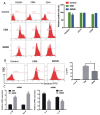Ontogeny of Synovial Macrophages and the Roles of Synovial Macrophages From Different Origins in Arthritis
- PMID: 31231364
- PMCID: PMC6558408
- DOI: 10.3389/fimmu.2019.01146
Ontogeny of Synovial Macrophages and the Roles of Synovial Macrophages From Different Origins in Arthritis
Abstract
The ontogeny of macrophages in most organ/tissues in human body has been proven. Due to the limited number and inaccessibility of synovial macrophages (SM), the origin of SM has not been fully illuminated. The objective of this study was designed to investigate the ontogeny of SM and to evaluate the role of SM from different origins in arthritis. Two origins of SM, embryonic SM (ESM) and bone marrow SM (BMSM) were identified in Cx3cr1-EGFP mice, CCR2-/- mice and bone marrow (BM) chimera model by using a stringent sorting strategy. The cellular features, including dynamic total cell number, in situ proliferation, phagocytosis and expressions of pro-inflammatory and anti-inflammatory genes, of ESM and BMSM were compared. In addition, ESM and BMSM showed different expression patterns in Rheumatoid Arthritis (RA) patients' synovium and during the developmental process of collagen-induced arthritis (CIA) mice. Taken together, these results demonstrated that the SM at least has two origins, ESM and BMSM. The different cellular property and dynamic expression patterns in RA patients/CIA mice highlight the notion that ESM and BMSM might play different role in arthritis.
Keywords: BMSM; CIA; ESM; RA; SM; ontogeny.
Figures






Comment in
-
Origins of synovial macrophages revealed.Nat Rev Rheumatol. 2019 Aug;15(8):451. doi: 10.1038/s41584-019-0260-4. Nat Rev Rheumatol. 2019. PMID: 31235836 No abstract available.
Similar articles
-
Increased synovial expression of IL-27 by IL-17 in rheumatoid arthritis.Inflamm Res. 2012 Dec;61(12):1339-45. doi: 10.1007/s00011-012-0534-7. Epub 2012 Jul 24. Inflamm Res. 2012. PMID: 22825627
-
Characteristics of synovial fluid effusion in collagen-induced arthritis (CIA) in the DA rat; a comparison of histology and antibody reactivities in an experimental chronic arthritis model and rheumatoid arthritis (RA).Clin Exp Immunol. 1997 Mar;107(3):480-4. doi: 10.1046/j.1365-2249.1997.3311221.x. Clin Exp Immunol. 1997. PMID: 9067521 Free PMC article.
-
IL-17 increases cadherin-11 expression in a model of autoimmune experimental arthritis and in rheumatoid arthritis.Immunol Lett. 2011 Oct 30;140(1-2):97-103. doi: 10.1016/j.imlet.2011.07.003. Epub 2011 Jul 20. Immunol Lett. 2011. PMID: 21798287
-
Synovial Macrophages in Rheumatoid Arthritis: The Past, Present, and Future.Mediators Inflamm. 2020 Apr 13;2020:1583647. doi: 10.1155/2020/1583647. eCollection 2020. Mediators Inflamm. 2020. PMID: 32351318 Free PMC article. Review.
-
Fibroblast-like synoviocytes in inflammatory arthritis pathology: the emerging role of cadherin-11.Immunol Rev. 2010 Jan;233(1):256-66. doi: 10.1111/j.0105-2896.2009.00854.x. Immunol Rev. 2010. PMID: 20193004 Review.
Cited by
-
Aberrant Activation of Immune and Non-Immune Cells Contributes to Joint Inflammation and Bone Degradation in Rheumatoid Arthritis.Int J Mol Sci. 2023 Nov 1;24(21):15883. doi: 10.3390/ijms242115883. Int J Mol Sci. 2023. PMID: 37958864 Free PMC article. Review.
-
Repolarization of Unbalanced Macrophages: Unmet Medical Need in Chronic Inflammation and Cancer.Int J Mol Sci. 2022 Jan 28;23(3):1496. doi: 10.3390/ijms23031496. Int J Mol Sci. 2022. PMID: 35163420 Free PMC article. Review.
-
The role of macrophages in osteoarthritis and cartilage repair.Osteoarthritis Cartilage. 2020 May;28(5):544-554. doi: 10.1016/j.joca.2019.12.007. Epub 2020 Jan 8. Osteoarthritis Cartilage. 2020. PMID: 31926267 Free PMC article. Review.
-
Macrophage pyroptosis promotes synovial fibrosis through the HMGB1/TGF- β1 axis: an in vivo and in vitro study.In Vitro Cell Dev Biol Anim. 2023 Apr;59(4):289-299. doi: 10.1007/s11626-023-00769-z. Epub 2023 May 17. In Vitro Cell Dev Biol Anim. 2023. PMID: 37195554
-
sTNFRII-Fc modification protects human UC-MSCs against apoptosis/autophagy induced by TNF-α and enhances their efficacy in alleviating inflammatory arthritis.Stem Cell Res Ther. 2021 Oct 9;12(1):535. doi: 10.1186/s13287-021-02602-4. Stem Cell Res Ther. 2021. PMID: 34627365 Free PMC article.
References
Publication types
MeSH terms
LinkOut - more resources
Full Text Sources
Other Literature Sources
Medical
Molecular Biology Databases

